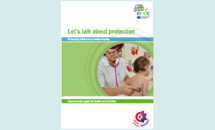Let’s talk about protection: enhancing childhood vaccination uptake
Helping parents to understand vaccination and supporting their choice to get their children protected is one of the most important aspects of the work of a primary healthcare professional.
Effectively communicating and addressing patients’ concerns is a task that could require effort, skills and time. Family doctors, nurses and other vaccination providers should feel comfortable when discussing vaccination and motivating carers to get children protected.
Download

Unprotected and under-protected populations
Recent studies have identified a range of characteristics for those who are not getting vaccinated or are not getting all recommended vaccinations. Four key population groups have been identified:
- ‘The hesitant’ – those who have concerns about perceived safety issues and/or are unsure about needs, procedures and timings for immunisation.
- ‘The unconcerned’ – those for whom immunisation is considered a low priority with no real perception of risk from vaccine preventable diseases.
- ‘The poorly reached’ – those with limited or difficult access to services, related to social exclusion, poverty and, in the case of more integrated and affluent populations, factors related to convenience.
- ‘The active resisters’ – those with personal, cultural or religious beliefs which discourage or exclude vaccination.
Key recommendations for communicating effectively with your patients
Research into the reasons behind a decision on whether or not to vaccinate, identified three key recommendations for healthcare providers:
1. Make vaccine communication more of a two-way information exchange
It has been noted that communication from healthcare providers, often due to time constraints, was generally too focused on one-directional communication and sending well intentioned but uniform messages to all. Instead, they are advised to place more emphasis on dialogues which first elicit information about parents’ specific concerns and anxieties and then adapt and customise messages to the identified needs of individuals and groups.
2. Keep the focus of discussions on the benefits of “getting protected and protecting”
While vaccine safety issues need to be directly and clearly addressed and reassurance given where parental concerns exist, parents and other experts called for healthcare providers to keep the focus of vaccination discussions on the benefits of protection. People need to be fully aware that when they get their children vaccinated, they are protecting them and the communities in which they live, from serious and potentially deadly diseases.
3. Make the settings and systems in which people obtain vaccinations simpler, more accessible and easier to navigate
It has been uniformly reported that there is a need to improve the design and provision of services and delivery systems. Advice calls for more attention to be paid to costs, location, staffing, transport, scheduling and timing as key determinants of vaccination programme uptake and success. “Vaccination journeys” need to be made easier.
Share your views
We encourage you to give us feedback on its usefulness and share with us good practice, materials and ideas that we can then spread across the EU and beyond. To give feedback, write to info@ecdc.europa.eu
More material on the topic
The following materials complement the ECDC guide Let’s talk about protection and can be used and adapted according to national strategies and initiatives, country needs and cultural considerations.
The presentation addresses healthcare practitioners (doctors, nurses), health mediators and other professionals involved in immunisation services, as well as medical students. It can be used during conferences, training initiatives and meetings in order to raise awareness on the importance of immunisation and discuss vaccination related issues.
The flipbook aims at supporting the conversations that healthcare workers involved in immunisation services have with parents, caregivers and patients. The material raises awareness on the importance of immunisation and addresses information needs on vaccination.
The flipbook has two sides: One side marked with ‘F’ for the facilitator, to aid during his conversation with the patient, and another side marked with ‘P’ that is shown to the patient during the conversation.
Publication data
Scientific and technical publications
Communication toolkit on immunisation: How to increase immunisation uptake
This ECDC communication toolkit aims to support EU/EEA countries in their communication initiatives to increase immunisation uptake, in particular childhood vaccination. It provides template materials that health authorities can adapt to develop their own communication initiatives, in line with national, regional or local strategies and needs.
Multimedia
Infographic - Measles is a serious disease
This ECDC communication toolkit aims to support EU/EEA countries in their communication initiatives to increase immunisation uptake, in particular childhood vaccination.
Multimedia
Infographic: Protect unborn babies from rubella
If a woman gets rubella shortly before getting pregnant or during the first three months of pregnancy, it is very likely to result in miscarriage or congenital anomalies known as congenital rubella syndrome (CRS).
Scientific and technical publications
Leaflet - Measles is a serious disease
This ECDC communication toolkit aims to support EU/EEA countries in their communication initiatives to increase immunisation uptake, in particular childhood vaccination.
Scientific and technical publications
Leaflet - What is community immunity?
This ECDC communication toolkit aims to support EU/EEA countries in their communication initiatives to increase immunisation uptake, in particular childhood vaccination.
Scientific and technical publications
Leaflet - Evaluating Internet sources of immunisation information
This ECDC communication toolkit aims to support EU/EEA countries in their communication initiatives to increase immunisation uptake, in particular childhood vaccination.
Scientific and technical publications
Leaflet - The immunisation visit
This ECDC communication toolkit aims to support EU/EEA countries in their communication initiatives to increase immunisation uptake, in particular childhood vaccination.
Scientific and technical publications
Let's Talk About Protection flipbook
This ECDC communication toolkit aims to support EU/EEA countries in their communication initiatives to increase immunisation uptake, in particular childhood vaccination.



